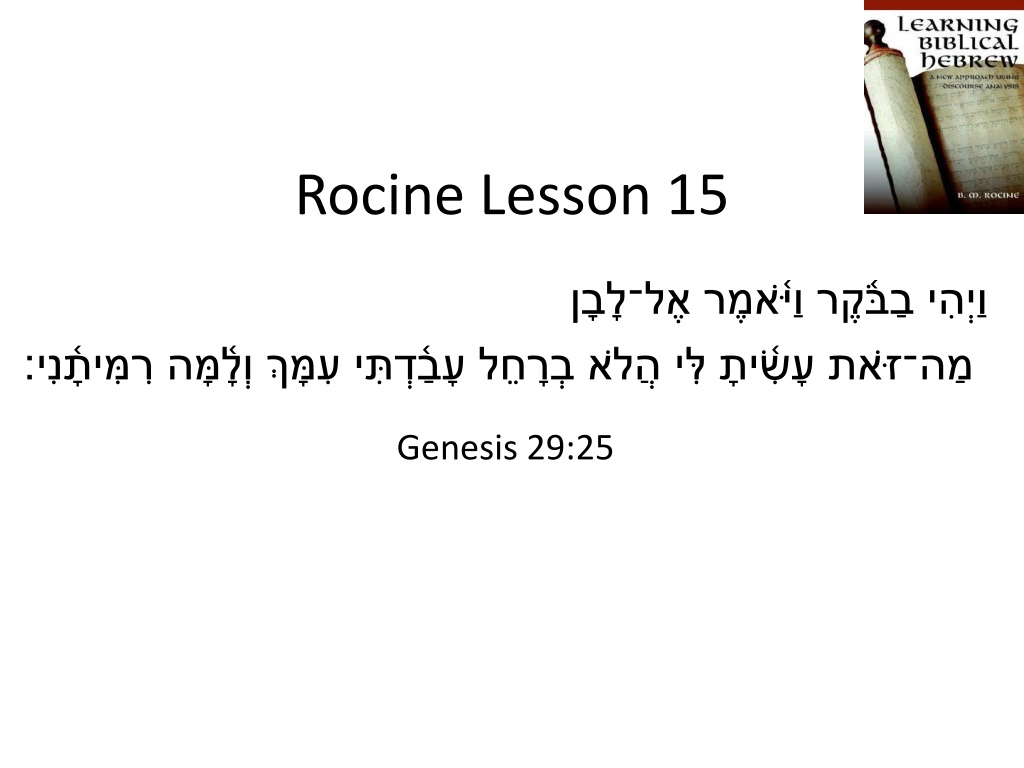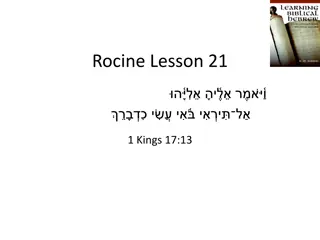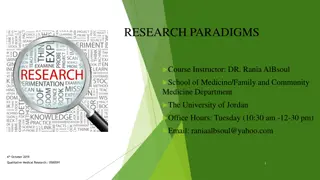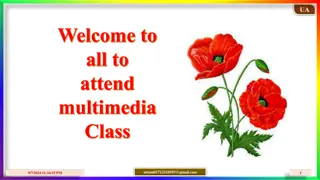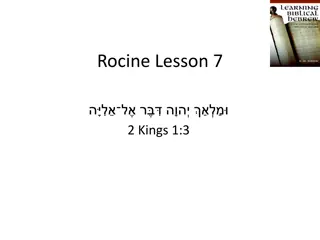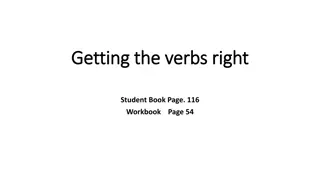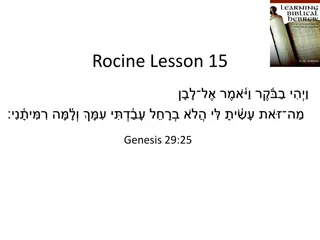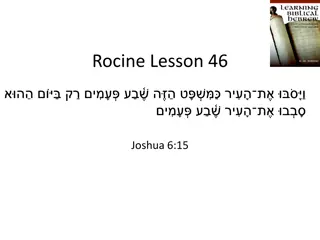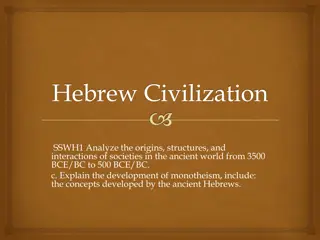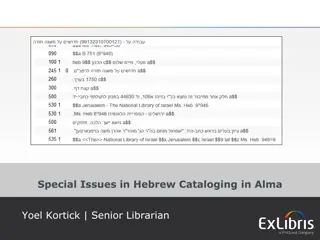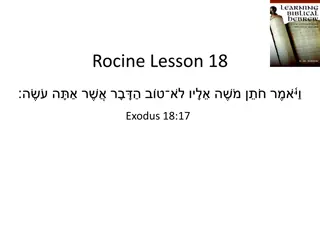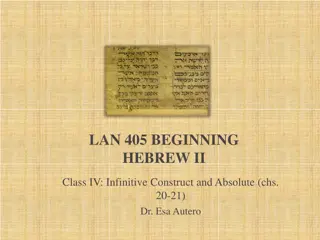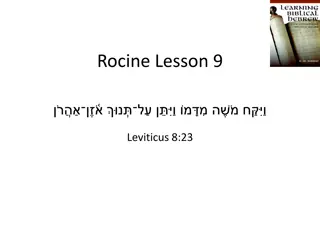Understanding Hebrew Verb Forms: Qal Qatal and Piel Qatal Paradigms
Explore the rules and nuances of using definite articles with prepositions, verb forms, and verb charts in Hebrew. Learn how to identify and read the Qal Qatal and Piel Qatal paradigms, and understand the significance of prepositions with the definite article. Dive into verb charts for Qatal and decipher the implications of certain vowel patterns and consonant markings. Enhance your understanding of Hebrew grammar with animated lectures and practical examples.
Download Presentation

Please find below an Image/Link to download the presentation.
The content on the website is provided AS IS for your information and personal use only. It may not be sold, licensed, or shared on other websites without obtaining consent from the author. Download presentation by click this link. If you encounter any issues during the download, it is possible that the publisher has removed the file from their server.
E N D
Presentation Transcript
Rocine Lesson 15 Genesis 29:25
Goals Identify and read o definite article with a preposition o Qal qatal and Piel qatal paradigms o questions
Preposition with the nikkud of the definite article means in the morning not in a morning
Preposition with the nikkud of the definite article RULE: When (or the other prefixed prepositions) precede the definite article the is normally dropped, and the preposition receives the 's nikkud We translate with the word the, as in in the.
Preposition with the nikkud of the definite article RULE: When (or the other prefixed prepositions) precede the definite article the is normally dropped, and the preposition receives the 's nikkud We translate with the word the, as in in the. See Animated Hebrew lectures Chapter 5: Article and Inseparable Prepositions (3:42)
Verb charts for qatal What form are the 2 pink verbs? What form are the 3 blue verbs?
Verb charts for qatal What form are the 2 pink verbs? What form are the 3 blue verbs? wayyiqtol qatal
Verb charts for qatal Notice prefixes on the wayyiqtol affixes on the qatal
Verb charts for qatal What does this qamets indicate?
Verb charts for qatal What does this qamets indicate? First root qamets in an affix form (i.e. a verb form with no prefix) indicates Qal Qatal.
Verb charts for qatal What does this dagesh indicate? What does this qamets indicate? First root qamets in an affix form (i.e. a verb form with no prefix) indicates Qal Qatal.
Verb charts for qatal What does this dagesh indicate? What does this qamets indicate? Doubling of the second root letter indicates Piel. This is true of Piels in ANY form. First root qamets in an affix form (i.e. a verb form with no prefix) indicates Qal Qatal.
Verb charts for qatal What does this dagesh indicate? What does this hireq indicate? What does this qamets indicate? Doubling of the second root letter indicates Piel. This is true of Piels in ANY form. First root qamets in an affix form (i.e. a verb form with no prefix) indicates Qal Qatal.
Verb charts for qatal What does this dagesh indicate? What does this hireq indicate? What does this qamets indicate? Doubling of the second root letter indicates Piel. This is true of Piels in ANY form. First root qamets in an affix form (i.e. a verb form with no prefix) indicates Qal Qatal. Piel Qatal
Verb charts for qatal So, we have 3 qatals in this verse 2 in the Qal 1 in the Piel
Verb charts for qatal The endings (affixes) here are new so we need to study the full paradigm of the Qatal. The best way to learn this is to learn the STRONG verb paradigm first. STRONG means none of the consonants do weird things (drop, assimilate, change the vowels around them, etc.)
Verb charts for qatal Principle for learning Hebrew verb paradigms 1. Learn the Qal first, then note the differences for the other stems (e.g. Piel) 2. Learn the STRONG verb paradigm first, then note the difference for the various WEAK verbs. For WEAK verbs learn the rules, e.g. missing letter rules.
Verb charts for qatal In Rocine see the verb charts on page 80 and the back of the book (p. 393ff) Typo Alert Note the following typos in the Rocine charts on page 80. (The charts at the back of the book are correct.) 1. Chart at top of page: III-Heh 2mp/2fp should have a hataph-patach as the 1st root vowel, rather than the simple shewa. 2. Chart at bottom of page: For the Piel Strong root , there are two 3ms forms given. One of them should have a tsere for the 2nd root vowel. E.g. it should read . For the Piel of there should not be a dagesh in the tsade.
Verb charts for qatal For now, memorize the Qal Qatal of the STRONG verb (see next slide). This is foundational for the other stems (e.g. Piel) and for the WEAK verbs (e.g. I-nun, I-yod, III-He, Hollow etc.)
Qal Qatal (STRONG verb) Singular Plural --- 3ms 3cp 3fs 2ms 2mp 2fs 2fp 1cs 1cp See animated hebrew lectures chapter 10 for a detailed explanation.
Questions, questions Our lesson verse also has 3 questions. Let s reformat the verse and see if we can spot the questions.
Questions, questions Question 1 Question 2 Question 3 These 3 questions are formed in 3 different ways. Can you guess what the question indicator is for each?
Questions, questions Question 1 Question 2 Question 3 Two are question words and the other is something called the interrogative heh.
Questions, questions Question word what Question 1 Interrogative heh Question 2 Question word why Question 3 Two are question words and the other is something called the interrogative heh.
Pausal forms This is a pausal form. Words in pause can change slightly in accent and vowels. Here the suffix has changed to making it look like it is the feminine suffix (2fs), but it is really just the masculine suffix (2ms) in pause. Tricky. Most pausal forms, however, do not cause confusion.
